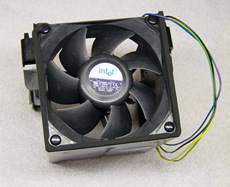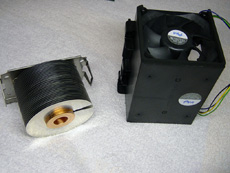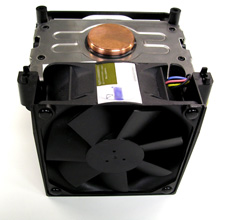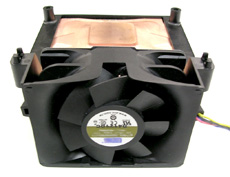Intel's Long Awaited BTX Form Factor
by Purav Sanghani on November 15, 2004 5:31 AM EST- Posted in
- Cases/Cooling/PSUs
BTX Cooling and Airflow
Again, the main reasoning behind Intel during the redesign of the ATX form factor was to design a more efficient cooling solution. As components are built faster they also run hotter. The ATX form factor improved on the AT specifications by placing the CPU closer to the back of the case where fans could be mounted as exhausts to pull hot air from the CPU out of the chassis and away from other components. Now that those other components in PCs are beginning to expand in performance and functionality they are running at temperatures as high as that of CPUs so a new design needed to be devised to help cool these components in a more efficient manner than just slapping more fans in a standard case. Now, we have come full circle with the CPU moving back towards the front of the case. Since Intel has the standards on PCIe very heavily controlled, worrying about PCIe cards extending too far to the front of the case should not be a problem.Intel implements a more efficient passive cooling system by placing the majority of components inline with the CPU towards the rear of the chasis.
 Click to Enlarge |
 Click to Enlarge |
The most important piece of hardware when it comes to cooling is the CPU heat sink fan. Without this a CPU would not POST, and would most likely damage the hardware. Intel has included what it calls a "BTX Thermal Module" which consist of either a spiral or stacked-fin heatsink and a fan which is mounted at the end of a plastic duct, facing the front end of the case. Intel has not limited this hardware to only one type though. In their virtual press kit Intel speaks of Type I (Standard height) and Type II (Low profile) thermal modules. The Type I module will be designed for a broader range of cases from small form factor to the larger full tower applications while the Type II module will be designed specifically for the ultra-small form factor designs.
 Click to Enlarge |
 Click to Enlarge |
Intel also mentioned that along with those two types of thermal modules there will be variations in the units for processors rated at different Thermal Design Power, or TDP levels. The difference in modules will exist mainly with the heatsink, with slight variations in the duct. The fan will, however, remain the same within the same type (Type I/Type II) of module.
This thermal module was the only piece of cooling hardware aside from the power supply which we found to be surprising. We couldn't imagine running an ATX case with only one CPU heatsink fan and we have our doubts about Intel's single module design, but we will leave that to our benchmarks to decide.










77 Comments
View All Comments
stephenbrooks - Monday, November 15, 2004 - link
Do you think if you connect the power to the fans the other way around you can get air to flow in from the front and come out of the back instead?SolarWind - Monday, November 15, 2004 - link
Actually, I like how they moved the processor towards the front of the case. This way the processor isn't in the path of hot air rising from the video card.Also, having the video card flipped over means that high performance heat sinks on the video card won't block a PCI/PCI Express slot.
DeeTees - Monday, November 15, 2004 - link
Your right, I would have sworn that I saw that mess inside of a Packard-Bell. At least they have not yet started using custom fasteners that you need a special tool to replace or upgrade components. (?)quanta - Monday, November 15, 2004 - link
BTX may deliver overall cooler temperature per volume of space, but what about all the hot air that was used to cool the CPU? Wouldn't the hot exhaust cook the video card and bridge controller, limiting overclocking potentials? Temperature aside, having air intake in front of the case reduces usable drive spaces that would be used for fan controllers. If I were designing BTX, I would put CPU on top corner, and a curved 'casing' that would route exhaust to top blowhole.PuravSanghani - Monday, November 15, 2004 - link
#42: Actually it us just these micrBTX cases that do not have rear exhausts...so far. We may see case manufacturers employing case fans as soon as BTX becomes a mainstream form factor.At Computex this past year, we did see some companies like Enlight (http://www.anandtech.com/casecooling/showdoc.aspx?... show off some mid tower cases which did have room to add extra case fans. We still have a lot to look forward to concerning the new form factor.
skunkbuster - Monday, November 15, 2004 - link
it would have been nice to have a rear exhaust...bob661 - Monday, November 15, 2004 - link
Man those P4's sure do run hot. 63C WITH the BTX case. My A64 runs at 36C inside the ancient ATX case. I'm still running the OEM CPU cooler and oh about 6 case fans. :-)Cygni - Monday, November 15, 2004 - link
Looks like BTX is going to work out for Dell and HP... but I dont think its going to have much effect for the enthusiast and self built markets. Seems to me that its going to be at its best in mBTX situations, but full BTX seems ho-hum. I guess its just more crap i gotta buy next time i upgrade. BTX mobo, BTX case, DDR2, SATA HD, PCI-Ex video card, new CPU... they really havent left anything for me to KEEP during a P4 to P4 upgrade. Me no likey.vedin - Monday, November 15, 2004 - link
Where am I supposed to put a window and neon light in that case? Hmm?Spinne - Monday, November 15, 2004 - link
I don't see what the problem is with BTX cases. The design layout, atleast for Intel processors makes a lot of sense as far as thermal regulation goes. Channeled airflow on ATX cases is a niche market, and the fact that there are no standards means that you can't be assured of compatibilty across motherboard solutions. You really don't want to have spent money on a new mobo and case only to find that a lousy capacitor prevents you from using channeled airflow. Also, there's no reason why a manufacturer can't place additional fans in a BTX case to cool the case further. Remember, cases are not upgraded as regularly as the actual hardware, so one always has the option of moving to BTX at one's lesuire. I dunno about you guys, but I live in a college dorm, and the smaller my case footprint is, the happier I am, especially if it's a full form-factor case.